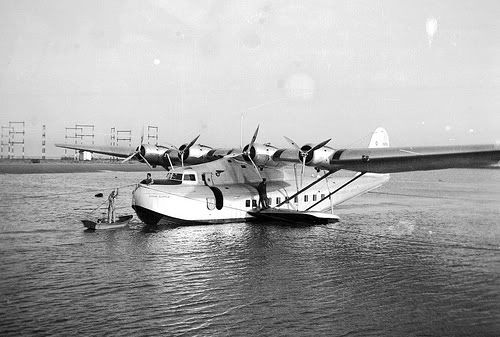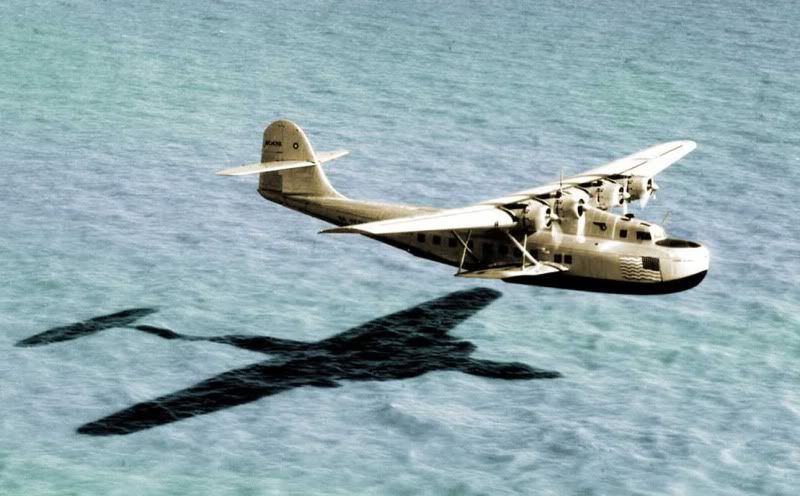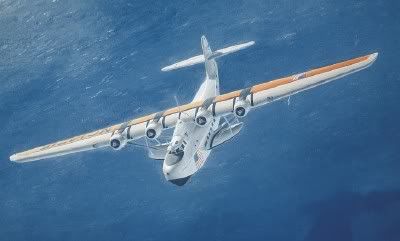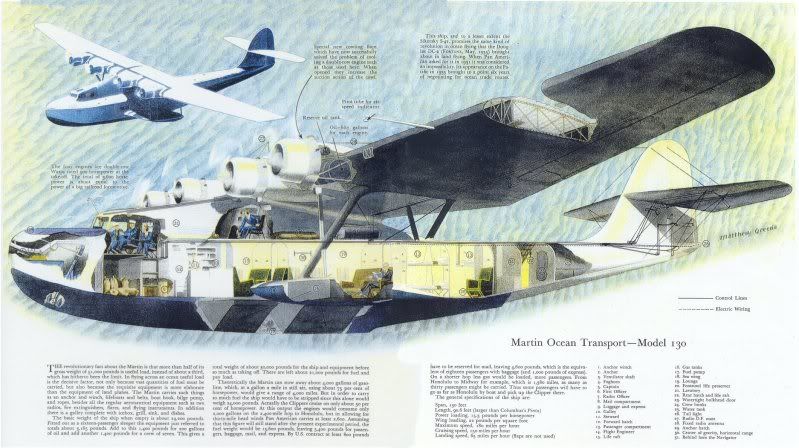Aristaeus
A-List Customer
- Messages
- 407
- Location
- Pensacola FL

At 6:08 AM on July 29th, 1938 Hawaii Clipper, NC 14714 call sign KHAZB lifted from the waves heading for the Philippines, leaving Guam behind for the last time. Along the way Hawaii Clipper would send out half hour weather and position reports to KMGB at Guam, KZDY at Panay in the central Philippines, and to KXBQ in Manila.

At 12:00, Hawaii Clipper transmitted in the clear her on the hour report:
"KHAZB, Flying in rough air, 9,100 feet. Temperature 13 degrees centigrade. Wind 19 knots per hour from 247 degrees. Position latitude 12 degrees 40 minutes east. Dead reckoning. Ground speed make good 112 knots. Desired track 282 degrees. Rain. During past hour cloud conditions have varied. 10/10ths of the sky covered by cumulus clouds whose tips were 9,200 feet. 5/10ths of hour on instruments. Last direction finder bearing from Manila 101 degrees true."
At 12:11 KZDY at Panay acknowledged Hawaii Clipper's report and requested permission to transmit the noon weather sequence. Hawaii Clipper signaled, "Stand by for one minute before sending as I am having trouble with rain static."
At 12:12 KZDY Panay requested for the second time permission to transmit the weather sequence, and receved no reply. Hawaii Clipper had vanished. The official time of her disappearence was listed as 12:11
By 13:30 the Pacific bases were put on emergency standby, and by 00:01 the U.S. Navy had fifteen vessels, six long-range bombers, and two small amphibians combing the sea between Guam and the Philippines.
With half hour position reports and RDF bearings which had been taken by the three monitoring stations the U.S. Navy searched for over a week and found nothing. No wreckage, no bodies, no debrie, nothing.

Immediately after receiving word from Manila the U.S. Army transport ship Meigs, which had been sailing just 70 miles from Hawaii Clippers noon position began her search. During the 29th hour of her search Meigs spotted an oil slick just 28 miles from Hawaii Clippers last known position. The oil slick was a 1,500 foot circle of oil rolling with the sea and Meigs launched a boat to take oil samples, which later proved not to have come from Hawaii Clipper.
No bodies, no wreckage, no debrie. Hawaii Clipper had vanished.
Footage of Hawaii Clipper.
[video=youtube;SiYJEnLvKOk]http://www.youtube.com/watch?v=SiYJEnLvKOk&feature=view_all&list=PLFEDE6E571AB46CF4&index=1[/video]
Passengers:
Choy Wah Sun (Watson Choy), 38, Jersey City, New Jersey:
Mr. Choy was a restauranteur with a tearoom in Manhattan and two restaurants in Jersey City with his best known restaurant named for the China Clipper.
Mr. Choy was en route to China to visit his brother Frank who was serving in the Chinese Air Force, and was also delevering 3 million dollars to the Kuomintang government in Chungking for war relief.
Howard C. French, Major, USAACR, Portland, Oregon:
Maj French was the active commander of the 321st Observation Squadron, and was en route to China and had stated to a reporter from the Oreganian before his departure that he would be making his way to Canton China to observe Japanese bombings of that city.
Kenneth A. Kennedy, 45, Oakland, California:
Mr. Kennedy was the traffic manager for PAA's Pacific Division, and was en route to the Orient on company business, possibly to reschedule the connections with CNAC (China National Aviation Corporation) which had been disrupted as the result of recent Japanese military advances.
Fred C. Meier, PH.D, 45, Chevy Chase, Maryland:
A botanist, and plant pathologist with the Department of Agriculture. In 1937, Mr Meier had arranged with Amelia Earhart to have Fred Noonan use an air-hook, which had been developed by Dr. Meier and Charles Lindbergh to collect airborne dust, pollen, spores and disease germs at attainable altitudes. Fred Noonan had taken such samples over the Atlantic portion of the flight around the world and Mr Meier had been able to establish with the samples sent back by Amelia Earhart that at least forty micro-organisms, plant and disease, were being carried across the Atlantic on the upper air currents. Mr Meier had hoped to prove the same with the Pacific leg of the flight but as we all know never recieved the samples.
Mr Meier had planned on takeing the samples during his trip across the Pacific onboard Hawaii Clipper.
Earl B. McKinley, MD, Colonel USAR, 43, Washington DC:
Dr McKinley was the Dean of the College of Medicine at George Washington University, and had been a Professor of Bacteriology at the college since 1931.
Widely recognized throughout the world as an expert on leprosy Dr. McKinley had studied this disease in the Philippines, where he was the field director for the Rockefeller Foundation and had served as a member of the Governor General's Advisory Committee on Leprosy. In May, 1938 Dr. McKinley had isolated a new strain of the leprosy micro-organism in an American leper, and in conjunction with Dr. Meier was traveling to the Philippines to determine whether a study of skin tests on Filipino lepers might reveal the very same micro-organism which he had isolated in the U.S. In addition, he and Dr. Meier were attempting to identify a vector for the transmission of leprosy, and other diseases, from Asia to North America.
Edward E. Wyman Lt. Cdr., USNR, 45, Bronxville, New York:
Mr. Wyman was the former assistant to Pan American Airways president, Juan T. Trippe and was now Vice President of Export Sales for the Buffalo, New York, aviation firm, Curtiss-Wright Corporation. Mr Wyman was en-route to China to conclude buisness with the Chinese that would enable them to buy and install engines for the new Curtiss Hawk 75-A fighters (P-36) that china had bought to replace the Hawk 75 currently in service.
Crew:
Howard L. Cox, 35, Engineer officer and Aircraft and Engine Mechanic. 944 trans-Pacific hours.
William McCarty, 33, Flight Radio Officer. 11352 trans-Pacific hours.
Ivan Parker, 40, Flight Steward. 1200 trans-Pacific hours.
Jose M. Sauceda, 35, Third Officer Certified Transport Pilot. 1900 flying hours/570 trans-Pacific hours.
Thomas B. Tatum, 29, Asst. Eng. Officer and Aircraft and Engine Mechanic. 35 trans-Pacific hours.
Leo Terletsky, 43, Captain Certified Transport Pilot. 9200 flying hours/1626 trans-Pacific hours.
Mark A. Walker, 26, First Officer Certified Transport Pilot. 1900 flying hours/1575 trans-Pacific hours.
Sources:
Fix on the Rising Sun
by Charles N. Hill.
1st Books Library.
Copyright 2000.
China Clipper.
BY Ronald W. Jackson.
Everest House.
Copyright 1980.

General characteristics:
Crew: 6-9 (Captain, First Officer, Junior Flight Officer, Engineering Officer, Assistant Engineering Officer, Radio Operator, Navigation Officer, plus cabin stewards)
Capacity: 36 day, 18 night passengers
Length: 90 ft 10 ½ in
Wingspan: 130 ft
Height: 24 ft 7 in
Max takeoff weight: 52,252 lb
Powerplant: 4 × Pratt & Whitney R-1830-S2A5G Twin Wasp 14-cylinder radial engines, 830 hp later 950 hp with hydromatic propellers each
Performance:
Maximum speed: 180 mph
Cruise speed: 130 mph
Range: 3,200 mi
Service ceiling: 10,000 ft